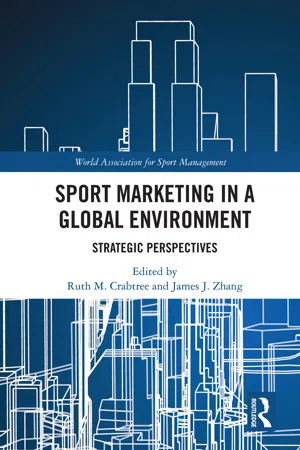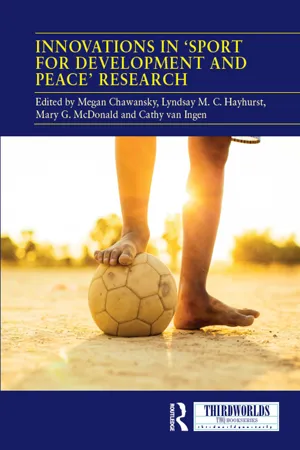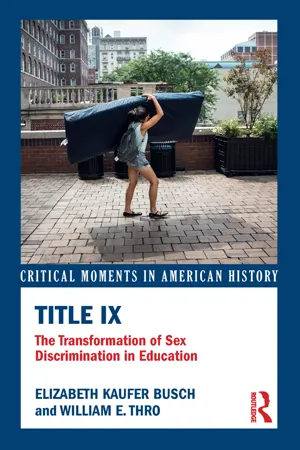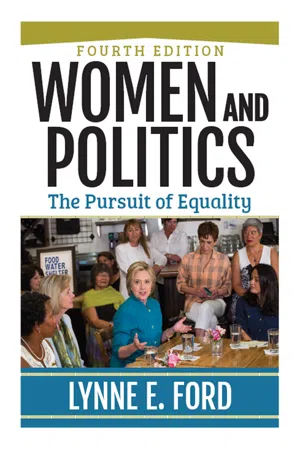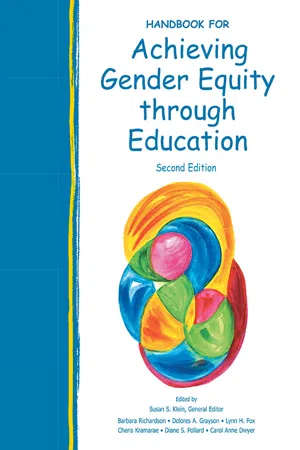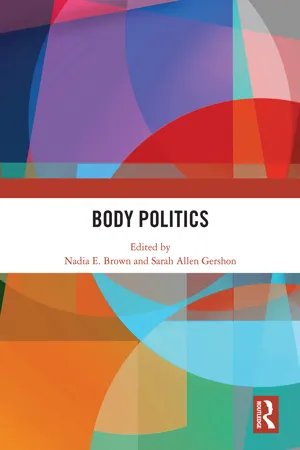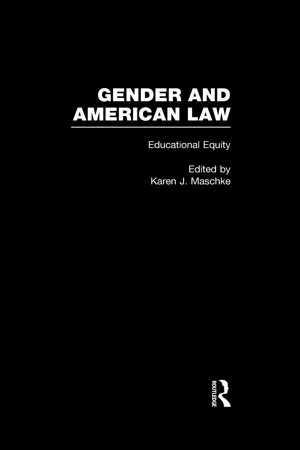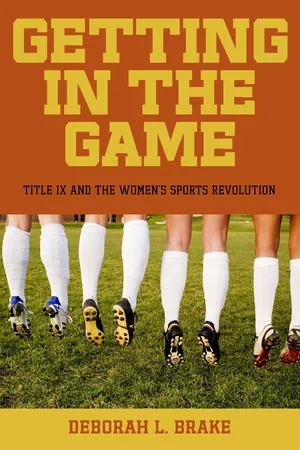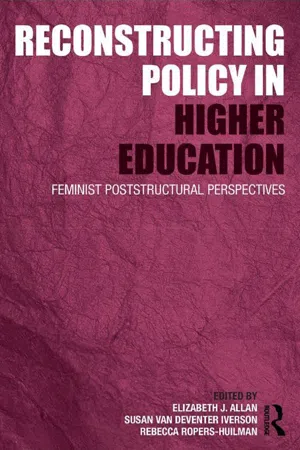Politics & International Relations
Title IX
Title IX is a federal civil rights law in the United States that prohibits sex-based discrimination in educational institutions that receive federal funding. It has had a significant impact on promoting gender equality in education and has been used to address issues such as sexual harassment, gender-based violence, and equal opportunities in sports.
Written by Perlego with AI-assistance
Related key terms
Related key terms
1 of 4
Related key terms
1 of 3
11 Key excerpts on "Title IX"
- eBook - ePub
Gender in the Classroom
Foundations, Skills, Methods, and Strategies Across the Curriculum
- David Sadker, Ellen S. Silber(Authors)
- 2016(Publication Date)
- Routledge(Publisher)
actions you can do, in or beyond class. The final interaction is an authentic assessment task—a real-world evaluation that gives you the opportunity to put your Title IX knowledge in action.ESSENTIAL EQUITY QUESTION 3.1: WHAT IS Title IX AND WHY DO WE NEED IT?
For more than 30 years, the federal law Title IX has prohibited sex discrimination in education. The law was enacted in 1972 as a broad proscription against discrimination in any federally funded education program or activity. It states “No person in the United States shall, on the basis of sex, be excluded from participation in, be denied the benefits of, or be subjected to discrimination under any education program or activity receiving Federal financial assistance” (Title IX of the Education Amendments of 1972, 20 U.S.C. Section 1681).Title IX requires educational institutions to maintain policies, practices, and programs that do not discriminate against anyone on the basis of sex. It is the nation's educational promise that the talents of all its citizens—women and men, girls and boys—will not be restricted by discrimination. Today, Title IX provides legal protection against sex discrimination for approximately 70 million students and employees in all educational institutions receiving federal financial assistance (National Coalition for Women and Girls in Education, 2002; U.S. Department of Education, 2006). The law also covers institutions such as vocational training centers, public libraries, and museums. It was intended to ensure equal opportunity for women and girls in all aspects of education—from access to higher education to equal opportunities and fair treatment in elementary and secondary classrooms to equal opportunity in athletics. In this chapter, you will have the opportunity to understand the letter of the law—the legal requirements of Title IX—as well as to embrace the spirit of Title IX—a broader notion of equity that integrates gender with related issues of race, culture, disability, ethnicity, sexual orientation, and socioeconomic status. Access, achievement, and equity—isn't that what educational excellence is all about? - eBook - ePub
Sport Marketing in a Global Environment
Strategic Perspectives
- Ruth M. Crabtree, James J. Zhang, Ruth M. Crabtree, James J. Zhang(Authors)
- 2022(Publication Date)
- Routledge(Publisher)
The Department of Education created the amendments of Title IX in 1972 to prohibit discrimination based on gender in any program of education or federal funded activity (OCR, 2015), which resulted in a nationwide revolution in the treatment of women in collegiate athletics. Part of Title IX reads:No person in the United States shall, on the basis of sex, be excluded from participation in, be denied the benefits of, or be subjected to discrimination under any education program or activity receiving Federal financial assistance(OCR, 2015).In other words, Title IX prohibits gender discrimination in educational institutions supported by federal funds in the United States – including high-schools, colleges, and universities (Walters & McNeely, 2010). By the law, the institutions were required to not only assign a Title IX coordinator to manage discrimination claims in educational programs but also publish guidelines for employees and students.After Title IX was signed into law in 1972, the legislative and political debates focused on applicability to sport, in particular, football and intercollegiate sports (Stevenson, 2007). However, many opponents of Title IX had concerns about the fiscal implications of equal spending on male and female sports and tried to weaken this requirement through an amendment to exempt “revenue-producing” sports (Kahn, 2007; Stevenson, 2007). Ultimately, these amendments were not applied. The final regulations of Title IX were released in 1975, and federally funded institutions had to be compliance by 1978 (Stevenson, 2007). The rules indicated that female students could try out for male teams if an institution did not have a female team and required setting up equipment and making facilities available for female students.However, due to a potential fiscal burden to the institutions, another three-pronged test replaced these rules (Stevenson, 2007). The three-pronged test required institutions to provide equal opportunity to male and female students, rather than focusing on a single compliance standard. By the law, institutions must (1) provide equal sport participation rates between male and female students, (2) demonstrate a history of expansion of the female athletic programs, and (3) meet the demand of female students (Li et al., 2009; Stevenson, 2007). - Megan Chawansky, Lyndsay Hayhurst, Mary G. McDonald, Cathy van Ingen(Authors)
- 2020(Publication Date)
- Routledge(Publisher)
This global initiative that champions Title IX does so in ways that disarticulate the statue from its litigious and contentious history to re-imagine Title IX in ways which exist outside of the social, legal, and political history through which the legislation was produced. As numerous feminist scholars have pointed out, much as with similar liberal feminist policies, since its inception in 1972 Title IX has been subject to litigation and adversarial adjudication as interpretations have developed over the course of time within US legal and sporting contexts. The law was designed to end gender discrimination within educational institutions and was then applied to sport. Increasingly, the statute has been used to stop sexual harassment and assault on college campuses, but its status as related to sports discrimination adjudication remains.In the 1970s, Title IX stood alongside other US liberal feminist strategies to offer ‘immanent critique’ by ‘revealing the gendered exclusions within liberal democracy’s proclamation of universal equality, particularly with respect to the law, institutional access, and the full incorporation of women into the public sphere.’20 The law did make inroads in regard to participation and resource allocation. For example, prior to Title IX, only 1 in 27 girls played varsity high school sport in the US and now that number is closer to 1 in 2 girls.21 Again, in the years before Title IX only 32,000 women competed in intercollegiate sport and that number is approximately 150,000 participants today.22 Women now enjoy roughly 43% of the total athletic scholarship opportunities available for playing college sports.23Far from a straightforward movement to progress, closer inspection of the history of Title IX reveals a complicated terrain. For example, requirements for the law’s implementation took several years to develop. The policy was further weakened by opponents’ legal manoeuvres in the 1980s during the administration of President Ronald Reagan. Full implementation of Title IX again faced backlash under the administration of George W. Bush – although female athletes also took to the courts in order to force compliance over the course of the policy’s history.24This often-contentious legislation and implementation history is rarely noted in State Department accounts. Dominant US sport for development framings are instead influential in promoting sporting access as a means of personal empowerment and community building. For example, Clinton’s speech to introduce the new sport development programmes includes references to the importance of Title IX within the US context and is interlaced with discussions about the intangible, interpersonal values of increasing sport opportunities for girls and women globally. The speech also offered a chance for Clinton’s own personal reflection in recounting the presumed progress that has been made in regard to sporting access. Indeed, Clinton told an audience at the Benjamin Franklin Room at the Department of State that- eBook - ePub
Title IX
The Transformation of Sex Discrimination in Education
- Elizabeth Kaufer Busch, William E. Thro(Authors)
- 2018(Publication Date)
- Routledge(Publisher)
CHAPTER 1 The Adoption of Title IX A Ban on Sex Discrimination in EducationO n June 23, 1972, Richard Nixon signed Title IX into law as part of the Educational Amendments of 1972.1 Co-sponsored by Senator Birch Bayh and Congresswoman Patsy Mink, the law states:No person in the United States shall, on the basis of sex, be excluded from participation in, be denied the benefits of, or be subjected to discrimination under any education program or activity receiving federal financial assistance.2Considered by themselves, these thirty-seven words seem neither revolutionary nor controversial in twenty-first-century America, and yet Title IX’s subsequent transformation would come to mark a number of critical moments in the history of women’s rights, infusing every aspect of education in the United States. Title IX’s passage produced immediate changes to the 1970s classroom, altering the opportunities of students and teachers across the country. Yet, the most monumental changes were to come.Since the critical moment of its passage, the Federal Executive Branch and the U.S. Supreme Court (SCOTUS) have expanded and transformed Title IX’s enforcement, scope, meaning, and goals. Students today can invoke Title IX not only to receive equal opportunities in admissions, activities, and programs, but also to attain equal numerical outcomes in athletics, receive protection against sexual harassment and assault by teachers or students, and recover monetary damages when a school fails to ensure any of these things. These changes have been enacted, not by Congress, the legislative body whose primary purpose is to create law, but by appointed officials in the agency responsible for enforcing Title IX— the U.S. Department of Education’s Office for Civil Rights (OCR).3 - eBook - ePub
Women and Politics
The Pursuit of Equality
- Lynne Ford(Author)
- 2018(Publication Date)
- Routledge(Publisher)
Title IX, also known as the Educational Amendments of 1972, banned sex discrimination in education at all levels of formal education. The language of this legislation mirrored other equal protection legislation:No person in the United States shall, on the basis of sex, be excluded from participation in, be denied the benefits of, or be subjected to discrimination under any education program or activity receiving federal financial assistance.Cosponsored by Congresswoman Edith Green and Senator Birch Bayh, the bill met little opposition from within Congress or from lobbyists when it was introduced. In fact, Green specifically asked women’s organizations not to testify on behalf of the legislation, fearing the publicity would attract opponents and endanger the legislation’s chances for passage.15 While the legislation was designed to eliminate the crippling barriers in all sorts of educational programs, institutions, and curricula, the law is now almost exclusively described in relation to increasing women’s access to sports programs—even in accounts of the women’s movement or women’s history.16 The legislation specified that no federal funds could go to educational institutions that were already receiving federal dollars and practiced sex discrimination in any of their programs, including admissions, athletics, financial aid, counseling, facilities, and employment. Today, Title IX extends to issues of sexual harassment, sexual assault, pregnancy, and parenting.Sexual and Gender HarassmentIn 1992, the US Supreme Court ruled that a student could bring a Title IX claim for damages for a sexually hostile environment created by a teacher (Franklin v. Gwinnett County Public Schools). In Davis v. Monroe County Board of Education (1999), the Court ruled that schools may also be liable if one student harasses another student at school. Schools are obligated to take reasonable steps under Title IX to prevent and eliminate sexual harassment. A study by the AAUW found that 81 percent of students in public schools in grades eight through eleven had experienced some form of sexual harassment. Although girls were more likely to have experienced sexual harassment at some point in high school, boys reported experiencing sexual harassment “occasionally” or “often.”17 Unwelcome sexual comments, jokes, or gestures, whether in person or online, are the most common form of sexual harassment in middle and high school, experienced by 33 percent of all students in a single academic year.18 - eBook - ePub
Sports and the Law
Major Legal Cases
- Charles E. Quirk(Author)
- 2014(Publication Date)
- Routledge(Publisher)
Published in 1979, the definitive scheme called for equal per capita funding in the area of athletic scholarships for male and female athletes. It also dropped the requirement for equal per capita funding in the "laundry list" areas, because some sports were seen to be inherently more expensive than others. The document, instead, called for equivalency in kind, quality, and availability as to the facilities and services in question. The policy allowed nonequivalent funding for football and basketball if the differences were due to "nondiscriminatory factors," such as equipment cost, injury rate, and facilities required for the particular sport. Critics of the final policy interpretation argued that, in a society in which men and women were equal, it would not take a larger arena to house a men's basketball game than a women's basketball game. The contention is that society itself is inherently discriminatory about sports, which is of course the very condition which Title IX was intended to address.Despite having been diluted in the revised policy interpretation, Title IX seemed at last poised to begin its task or making sexual discrimination in publicly funded education an issue of the past. The final interpretation had, with regard to sports, two purposes. The first was to eliminate inequality within existing programs, while the second was to correct affirmatively the effects of past discrimination by requiring institutions to encourage females to participate in sports, to increase the number of sports offerings for women, and to publicize the availability of sports to potential female athletes. All of these efforts were designed to help raise the profile of women's athletics in society and, therefore, promote the overall acceptance of women into full equality within the society at large.Title IX enforcement is currently handled by the Office of Civil Rights within the Department of Education, which has devised a three-part test for determining if an institution is in compliance. First, a school must effectively accommodate the interests and abilities of both female and male student-athletes. Second, there must be an ongoing program expansion in any cases where there has been an underrepresented sex. Third, there must be proportionality in participation and opportunity for male and female athletes, that is, athletic opportunity must divide up about the same way as the student body does in terms of gender.The landmark Supreme Court case, Grove City College v. Bell, decided in 1984, showcased the central area of contention in the interpretation of Title IX. What constitutes an "educational program or activity?" Should the phrase be interpreted in a broad, institutional manner, as the HEW (which after 1980 became the Department of Education), contended? Or should it be interpreted in a narrower, "program-specific" context? The broad approach holds that if an educational institution receives any federal funding at all, then it cannot discriminate in any of its programs, regardless of whether or not a specific program receives direct federal financial assistance. The narrow approach is just the opposite. Unless a specific program, activity, or department of an institution receives directly earmarked federal aid, it is free to act in any manner it chooses, whether discriminatory or not. Prior to the Grove City College case, federal courts were split on the issue. The two major cases were The University of Richmond v. Bell, and Haffer v. Temple University - Susan S. Klein, Barbara Richardson, Dolores A. Grayson, Lynn H. Fox, Cheris Kramarae, Diane S. Pollard, Carol Anne Dwyer, Susan S. Klein, Barbara Richardson, Dolores A. Grayson, Lynn H. Fox, Cheris Kramarae, Diane S. Pollard, Carol Anne Dwyer(Authors)
- 2014(Publication Date)
- Routledge(Publisher)
Thus, sexual harassment can be physical, verbal, visual, or written. These behaviors are often committed by individuals who are in supervisory positions or peers. These behaviors also constitute sexual harassment if they occur between individuals of the same sex or between individuals of the opposite sex.According to Title IX of the 1972 Education Amendments:No person in the United States shall, on the basis of sex, be excluded from participation in, or denied the benefits of, or be subjected to discrimination under any educational program or activity receiving federal assistance.Title IX is an antidiscrimination statute prohibiting discrimination on the basis of sex in any educational program or activity receiving federal financial assistance. Title IX is at the heart of efforts to create gender-equitable schools. Title IX requires educational institutions to maintain policies, procedures, and programs that do not discriminate against anyone based on sex. Title IX extends to recruitment, admissions, educational activities and programs, course offerings, counseling, financial aid, health and insurance benefits, scholarships, and athletics.Schools must designate a Title IX Coordinator, whose responsibility is to enforce Title IX including the prevention of sexual harassment. They may also designate an additional sexual-harassment administrator or counselor. Schools can lose federal funds for noncompliance with Title IX and they can be sued if they fail to respond to and stop sexual harassment when someone has complained about it (Table 11.1 ).Table 11.1 Key Supreme Court Decisions Relating to Sexual Harassment and Education1979 Cannon v. University of Chicago Individual can bring a private lawsuit directly against an educational institution for violation of Title IX 1980 Alexander v. Yale University The definition of sex discrimination under Title IX includes sexual harassment 1982 North Haven Board of Education v. Bell Title IX can protect employees of educational institutions as well as students 1983 Grove City College v. Bell Limits Title IX to program specific coverage. If sexual harassment occurs in a dorm that didn’t receive federal funds, the student would not be protected. - eBook - ePub
- Nadia E. Brown, Sarah Allen Gershon, Nadia E. Brown, Sarah Allen Gershon(Authors)
- 2020(Publication Date)
- Routledge(Publisher)
29 Women’s bodies thought to be suspiciously strong, unnervingly fast, or too masculine, not only stretch gendered understandings of physicality, they defiantly undermine the male/female binary assumptions that constitute the political category of sex inherent to Title IX (Butler 1998). Yet contradictorily, the better and more competent the athlete, the greater the countervailing pressure to balance these physical feats by performing femaleness in gender normative ways. Sociologists demonstrate that gender policing of female athletes remains a factor on sports teams across the country and in media portrayals of women in sport (Cooky, Messner, and Musto 2015; Schultz 2014). Women athletes must now, politically and culturally, continue to perform a certain brand of femaleness (always already in juxtaposition to male bodies under Title IX) even as they compete in sports. In a perverse consequence of history, the price to pay for shifting understandings of women’s physicality is borne by the very bodies Title IX aims to empower.Perhaps two of the most important methods for evaluating any civil rights policy hinge on the extent to which it effectively curtails discrimination or circumvents potential discrimination by another name. Here, Title IX – and our shared understanding of it as a model of policy success – falls short, at least in part. Beyond the domain of sports, the naturalized practice of segregating women and men contributes to the difficulty in addressing continued and often pernicious discrimination against cisgender women, as well as transgender and intersex people. So long as we fail to acknowledge the fraught legacy of accepting purported sex difference at the core of policy design, we also remain haunted by attempts to renaturalize this false dichotomy in other policy applications (see also Davis 2014). The resurgence of bathrooms as a contested domain for transgender students and the problematic demands by conservative political groups that students adhere to bathrooms which serve their “real” sex underscore this point (see also Westbrook and Schilt 2014). Instead of ensuring students’ equal treatment regardless of whether their physical body matches their gender identity, Title IX’s reliance on the body as a fundamental category in education means that both trans- and cisgender students potentially face the requirement that they declare their embodied sex in order to be protected from discrimination on its basis. So long as Title IX continues to rely on policy design that invokes binary sex as a category in athletics, public policy will fail to afford non-discrimination protections to some of the most vulnerable populations in terms of gender-identity, race, economic class, and physical ability within educational institutions more broadly. - eBook - ePub
- Karen Maschke(Author)
- 2013(Publication Date)
- Routledge(Publisher)
12 The definition of women’s sports produced by Title IX leaves out women who are not collegians; women who play purely for fun rather than to win; women who want to be involved with sport.While acknowledging the role Title IX played in placing women’s sports on the federal agenda, an agenda for women and sports in the 1990’s must look beyond Title IX and women’s college athletics modeled on men’s college athletics. An agenda for women and sports in the 1990’s must: (1) eradicate the persistent stereotype that, although society accepts superwomen such as tennis players Chris Evert and Martina Navratilova and sprinter Florence Griffith Joyner, the only roles for ordinary women in the world of sport are as cheerleaders, baseball Annies13 and football widows;14 (2) secure a place for itself in the broader women’s movement; (3) recognize the diversity of women in and out of the women’s sports movement; and (4) address the needs of all women in sports, particularly in areas where women can make an impact on the current male model of sport.15The four strains of this agenda are intertwined. By securing a place for itself in the broader women’s movement, the women’s sports movement will be able to enlist the aid of women in academics and business who may be most capable and qualified to obtain positions as administrators and executives throughout all levels of athletics. The introduction of women who have not yet been involved in the women’s sports movement will help eradicate the myth that sports is only for the Chris Everts, Martina Navratilovas and Florence Griffith Joyners. In the world of sport, women need not accept the role of sideline appendage. Moreover, a broader linkage between the general women’s movement and the women’s sports movement will allow both groups to address the questions of how to meet the needs of diverse groups of women and how to jointly further women’s involvement in sport in the 1990’s.16 - eBook - ePub
Getting in the Game
Title IX and the Women's Sports Revolution
- Deborah L. Brake(Author)
- 2010(Publication Date)
- NYU Press(Publisher)
2The crux of their protest was these two simple words: Title IX . At the time, those words were little known among nonlawyers, beyond the few aficionados who followed women’s sports. Today, appeals to Title IX resonate broadly in American popular culture. Media coverage of every Olympics since 1996 has included frequent mention of Title IX and glowing statements attributing the success of female Olympians to the opportunities created by the law. Appeals to the sentiment behind the law, that women should have equal access to sports, help sell Nike shoes and have figured prominently in the company’s advertising campaigns.3 A women’s clothing catalogue titled simply “Title Nine” markets sportswear and casual clothing to active women.4 The statute has even influenced the characters and story lines on our viewing screens in television shows and movies.5 Title IX has worked its way into American popular culture as few other laws have.And yet, for all of its influence, it is a law that is little understood. Critics blame it for going too far and hurting men’s sports, calling it a “quota” law. As explained in later chapters, it is not. Even the law’s supporters do not always grasp its requirements. Popular newspaper accounts often describe Title IX as a law that mandates equal funding for male and female sports. This, too, is inaccurate. It is a law that means many things to many people, but it is rarely fully understood or appreciated, despite its fame and notoriety. And, for all of its impact on women’s equality—in sports and in society—it is a law that has been too often neglected in feminist scholarship examining the role of law in shaping understandings of gender and producing cultural change.This is a book about Title IX. It explores how and why it has been more successful than other sex discrimination laws, at least in certain respects, in getting women into arenas traditionally reserved for men and in changing cultural norms in the process. It also examines those areas of the law where progress has been disappointing and where the law has developed in a constricted or ineffectual way. - eBook - ePub
Reconstructing Policy in Higher Education
Feminist Poststructural Perspectives
- Elizabeth J. Allan, Susan Iverson, Rebecca Ropers-Huilman(Authors)
- 2009(Publication Date)
- Routledge(Publisher)
Changes in higher education and the later feminist movement in the 1960s and 1970s challenged the separatist strategy that emphasized women-specific athletic programs. The method of educating women transformed from coeducation to a gender-combined model of higher education characterized by equity. The purpose of educating women changed from a separate, distinct purpose based on gender, to a purpose of education for women based on civil and legal equality. Separatist strategies to maintain women’s athletic programs and governance of competition in previous generations were challenged. When Title IX went into effect on June 23, 1972, athletic programs were not specifically mentioned. Title IX simply states:No person in the United States shall, on the basis of sex, be excluded from participation in, be denied the benefits of, or be subjected to discrimination under any educational program or activity receiving Federal financial assistance. (Carpenter & Acosta, 2005, p. 3)The National Collegiate Athletic Association, the men’s governing organization, immediately challenged the application of Title IX in college athletics. Women leaders in the AIAW were integral in fighting the NCAA’s challenge to Title IX and continued to promote a separate women’s governance model of intercollegiate athletics.The Department of Health Education and Welfare (HEW) clarified how Title IX applied to athletics in its guidelines published on June 19, 1974. The guidelines stated that, “although few athletic departments directly received federal funding, sports would
Index pages curate the most relevant extracts from our library of academic textbooks. They’ve been created using an in-house natural language model (NLM), each adding context and meaning to key research topics.
Explore more topic indexes
Explore more topic indexes
1 of 6
Explore more topic indexes
1 of 4

